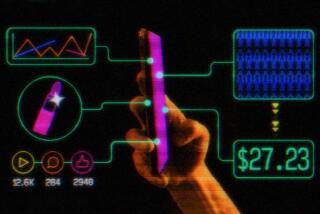This picture of Emily Ratajkowski is free to look at. But its NFT sold for $140,000

The puzzling world of NFTs (nonfungible tokens) just got even more puzzling to those on the outside looking in: A digital-only photograph of supermodel Emily Ratajkowski standing in front of a photograph of herself (with a smaller, different photograph of herself in the corner) just sold at auction at Christie’s for $140,000 ($175,000 after fees).
It’s not that the photo can be seen only by the buyer or even that the buyer can physically mount it in a frame (though one supposes the buyer could project it on a wall or screen and put a frame around the projection); it’s that the equivalent of the certificate verifying the authenticity of the digital file of the main photo is unique. It’s really the certificate that cannot be replaced exactly by a copy. And that is worth $175,000 to someone.
NFTs have recently enjoyed a heyday. Nonfungible.com, which tracks such sales, shows massive spikes through the first quarter of 2021 over the last quarter of 2020, with sales volume reportedly in the range of $2 billion already this year.
By definition, each NFT is unique (nonfungible) and digital only. Each lives on a blockchain, which is like a public spreadsheet that automatically updates whenever an NFT changes hands, supposedly guaranteeing that the digital object’s ownership can’t be faked. That doesn’t mean that each object represented by an NFT is unique, however. The band Kings of Leon recently offered its album “When You See Yourself” in exchange for a $50 NFT; the purchaser received a vinyl copy and a digital download. (Kings of Leon also offered higher-ticketed items such as lifetime front-row seats to their shows as NFTs.)
The gambit has reportedly paid off for the band to the tune of $2 million. In April, the Weeknd reportedly sold an eight-item NFT collection for $2 million in less than 24 hours. Twitter Chief Executive Jack Dorsey somehow sold his first-ever tweet as an NFT purchase for $2.9 million.
That’s nowhere near the ceiling for the items. A collage by a digital artist who goes by the name “Beeple” (born Mike Winkelmann) was auctioned in March by Christie’s for $69 million.
The Ratajkowski NFT and image (called “Buying Myself Back: A Model for Redistribution”) depicts her standing in front of a famous 2014 photograph of herself from Sports Illustrated. The model posted the SI photo on her Instagram account; that post, including some comments on it, was blown up and transferred to canvas by artist Richard Prince as part of his series “New Portraits,” in which he did the same to a number of Instagram posts by a number of people. Ratajkowski, a vocal proponent of models regaining control over their own images, purchased the canvas from Prince for about $81,000. She then had the photo shot of herself in front of the canvas, which is the digital image file linked to the NFT that just sold for $140,000.
If that sounds confusing, there are also the likely multiple layers of copyright infringement to be considered, as the owners and creators of the various images included in “Buying Myself Back: A Model for Redistribution” might reasonably argue degrees of ownership of the main image. Those owners could include Prince, Sports Illustrated and/or its photographer and Ratajkowski (for the main image and for the Instagram profile photo in the upper-left-hand corner and possibly for the Instagram post itself). Prince has been repeatedly sued for profiting off the use of base images he did not own.
The lot essay for the Christie’s auction casts the sale of the Ratajkowski NFT as reclaiming the model’s likeness for her own benefit, rather than for others’.
Ratajkowski “is intensely familiar with having her image wrested from her for another’s profit, as chronicled in her cataclysmic essay ‘Buying Myself Back,’ published in the September 2020 issue of ‘New York Magazine,’” it reads. “... In carving its presence on the immutable, universal Ethereum blockchain ledger, the NFT facilitates Ratajkowski’s message in a way that breaks new ground for feminist art history and practice.”
More to Read
The biggest entertainment stories
Get our big stories about Hollywood, film, television, music, arts, culture and more right in your inbox as soon as they publish.
You may occasionally receive promotional content from the Los Angeles Times.







